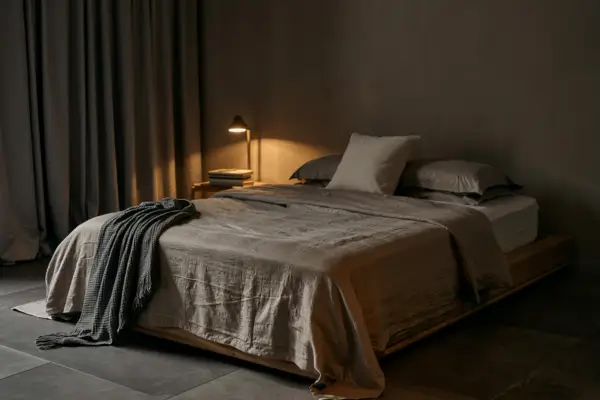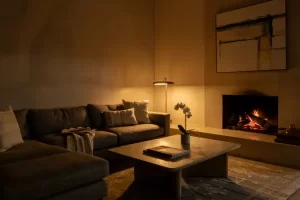In a world obsessed with brightness, shine, and open spaces, there is a subtle, sophisticated power in embracing the dark. Shadow and dimness—often overlooked—can be among the most luxurious tools in interior design. The quiet luxury of shadows is not about darkness for its own sake, but about depth, mystery, contrast, and calm. When used with intention, darkness doesn’t subtract from a space—it adds emotion, intimacy, and richness. This article explores how to use shadows and low light as active design elements to create more profound, sensorial, and refined interiors.
Rethinking Darkness in Interior Design
Traditionally, dark corners and dim spaces have been associated with neglect or gloom. But in modern, intentional design, they’ve become symbols of restraint, elegance, and serenity. Instead of flooding every room with artificial light, designers are now embracing the value of shadows—spaces where the eye can rest, emotions can settle, and textures can deepen. In Japanese aesthetics, this is known as “In Praise of Shadows”—a philosophy that celebrates the beauty found in the subtle gradations between light and dark.
The Emotional Role of Shadows
Shadows evoke emotion. They can make a space feel grounded, quiet, even sacred. Dim corners invite slowness. Darkness reduces visual noise and shifts focus from surface to feeling. This kind of ambiance creates an emotional pause—an invitation to reflect, breathe, and feel safe. Especially in a home environment, using shadows strategically allows you to carve out spaces for rest, intimacy, and sensory connection.
Lighting Design That Embraces Shadow
To design with darkness, you must master the art of controlled lighting. Instead of defaulting to bright ceiling lights, use indirect and layered lighting to create soft shadows and glow. The goal is not to eliminate light, but to shape it—allowing certain areas to remain quiet while highlighting others. Here’s how to build lighting that supports shadow play:
- Use floor and table lamps with low-lumen bulbs and warm tones to create intimate pools of light.
- Install dimmers on overhead lighting to adjust intensity based on mood or time of day.
- Try backlighting or hidden LED strips behind furniture or under shelves to create ambient glow.
- Let shadows form naturally behind large furniture pieces or textured walls.
Once you’ve created a base of ambient lighting and embraced the soft presence of shadows, the next step is to strategically direct light where it matters most. This helps highlight textures, create visual drama, and establish layers of mood in your interior space.
Playing with Directional Light
Light direction matters. Side lighting or uplighting emphasizes texture and depth more than top-down lighting. By casting shadows across curtains, stone, or wood grain, you add movement and richness to a space. Position lamps so they graze walls, not just illuminate them. The contrast between illuminated and unlit surfaces becomes an aesthetic statement.
Color Palettes That Welcome Darkness
Designing with shadows doesn’t require a blacked-out room. It’s about using muted, moody, or low-contrast colors that let shadow do its work. Earthy tones, deep blues, charcoals, and even muted greens absorb light gently, creating depth without harshness. These tones don’t reflect much, so they enhance the richness of dimly lit spaces instead of competing with the darkness.
- Dark taupe and mushroom grey: create quiet warmth without sterility.
- Deep indigo or ink blue: evoke depth, elegance, and calm.
- Olive and forest green: feel grounding and sophisticated in low light.
- Soft black or near-black: matte finishes absorb light and enhance shadow detail.
Beyond colors, the materials you choose can dramatically influence how shadows are cast, diffused, or absorbed in a room. Let’s explore how different textures and surfaces can deepen the visual narrative created by subdued lighting.
Materials That Interact with Shadow
Just as light reveals material, shadow defines its mood. Choose finishes and surfaces that respond well to low lighting. Matte textures, raw woods, natural stone, and woven fabrics all gain visual depth in dim light. Reflective materials should be used sparingly, to avoid disrupting the subtle ambiance.
- Raw wood: grain and imperfections catch light differently throughout the day.
- Linen and wool: offer softness and tactility that feel more pronounced in dim environments.
- Stone and clay: add earthy weight and shadow-friendly depth to interiors.
- Plaster and limewash walls: subtly reflect and scatter light, softening shadow edges.
After selecting shadow-friendly materials, it’s equally important to balance them with thoughtful contrast—without overwhelming the subtlety that defines this style. Let’s explore how to do this elegantly.
Using Contrast Without Harshness
When designing with shadow, contrast becomes poetic. A dark wall beside a lightly textured curtain. A matte black cabinet against a walnut floor. These juxtapositions make each element feel intentional and layered. Avoid stark black-and-white contrasts; instead, work within a controlled range of muted tones that support quiet visual drama.
Layout and Composition That Embrace Stillness
Shadow-driven design thrives in uncluttered layouts. Give space for darkness to gather. Instead of filling every wall or corner, leave room for shadow to settle. Open negative space, especially near windows or lamps, allows your eye to rest and your emotions to exhale. Use fewer objects, more thoughtfully placed. This type of stillness feels meditative and controlled.
Framing Shadow Moments
Just like light can highlight a sculpture or surface, shadow can frame it. A floating shelf lit from below. A painting half-cast in shade. A recessed alcove with no spotlight at all. These moments become sensory punctuation marks—silent but powerful—creating rhythm in the visual storytelling of your home.
Cultural and Historical Roots of Shadow Aesthetics
The use of shadow in design is not a modern invention—it has deep cultural and historical roots. In Japanese architecture, the traditional tea room is dimly lit, allowing participants to focus inward. In Gothic and Baroque spaces, dramatic shadow contrast was used to evoke reverence or awe. Even in mid-century modernism, low lighting and wood paneling created mood-rich environments. Understanding these precedents helps us see shadow not as absence—but as presence, design, and meaning.
When to Use Darkness—and When Not To
Not every room benefits from shadow play. Kitchens, workspaces, and bathrooms often need clarity and brightness. But even these rooms can feature contrast—perhaps in a matte backsplash, a shaded reading nook, or recessed floor lighting. The key is knowing when you want calm, depth, and softness—and reserving brightness for when you need energy and clarity. Use shadow intentionally, not universally.
Balance Is Luxury
True luxury lies in balance. When light and dark work together, a room breathes. It’s not about choosing one or the other, but orchestrating their relationship. A well-designed space lets your eyes wander between light and shadow, brightness and rest, presence and absence. This dance creates emotional and visual richness—the kind of quiet luxury that lingers in memory.
Conclusion
Shadow is not the absence of beauty—it is beauty itself, in its quietest form. By using darkness as a design element, you create space for emotion, depth, contrast, and calm. Whether through layered lighting, rich materials, or thoughtful layout, embracing shadow invites a new level of intention into your interiors.
In a culture that often equates value with visibility, shadow reminds us that meaning can also be found in silence, softness, and pause. Darkness, when curated with care, becomes not a void, but a vessel—holding space for serenity, reflection, and quiet luxury. It whispers instead of shouting, offering comfort where constant stimulation cannot.
As you design your spaces, consider not just what you want to see, but what you want to feel. In that pursuit, the luxury of shadow is not an omission—but a revelation.




